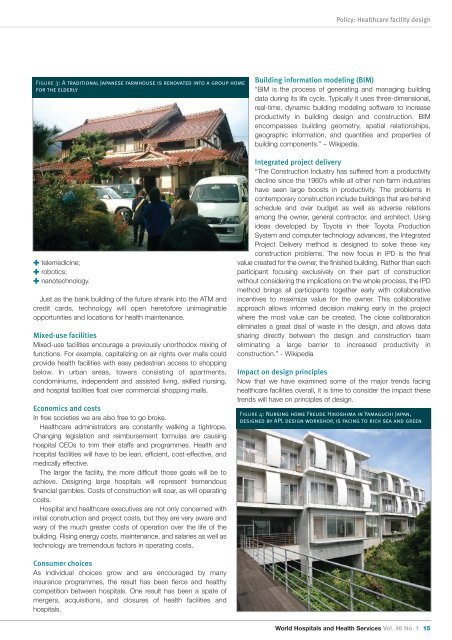vol46.1 LR.pdf - International Hospital Federation
vol46.1 LR.pdf - International Hospital Federation
vol46.1 LR.pdf - International Hospital Federation
You also want an ePaper? Increase the reach of your titles
YUMPU automatically turns print PDFs into web optimized ePapers that Google loves.
Policy: Healthcare facility design<br />
Figure 3: A traditional Japanese farmhouse is renovated into a group home<br />
for the elderly<br />
Building information modeling (BIM)<br />
“BIM is the process of generating and managing building<br />
data during its life cycle. Typically it uses three-dimensional,<br />
real-time, dynamic building modeling software to increase<br />
productivity in building design and construction. BIM<br />
encompasses building geometry, spatial relationships,<br />
geographic information, and quantities and properties of<br />
building components.” – Wikipedia.<br />
✚ telemedicine;<br />
✚ robotics;<br />
✚ nanotechnology.<br />
Just as the bank building of the future shrank into the ATM and<br />
credit cards, technology will open heretofore unimaginable<br />
opportunities and locations for health maintenance.<br />
Mixed-use facilities<br />
Mixed-use facilities encourage a previously unorthodox mixing of<br />
functions. For example, capitalizing on air rights over malls could<br />
provide health facilities with easy pedestrian access to shopping<br />
below. In urban areas, towers consisting of apartments,<br />
condominiums, independent and assisted living, skilled nursing,<br />
and hospital facilities float over commercial shopping malls.<br />
Economics and costs<br />
In free societies we are also free to go broke.<br />
Healthcare administrators are constantly walking a tightrope.<br />
Changing legislation and reimbursement formulas are causing<br />
hospital CEOs to trim their staffs and programmes. Health and<br />
hospital facilities will have to be lean, efficient, cost-effective, and<br />
medically effective.<br />
The larger the facility, the more difficult those goals will be to<br />
achieve. Designing large hospitals will represent tremendous<br />
financial gambles. Costs of construction will soar, as will operating<br />
costs.<br />
<strong>Hospital</strong> and healthcare executives are not only concerned with<br />
initial construction and project costs, but they are very aware and<br />
wary of the much greater costs of operation over the life of the<br />
building. Rising energy costs, maintenance, and salaries as well as<br />
technology are tremendous factors in operating costs.<br />
Integrated project delivery<br />
“The Construction Industry has suffered from a productivity<br />
decline since the 1960’s while all other non-farm industries<br />
have seen large boosts in productivity. The problems in<br />
contemporary construction include buildings that are behind<br />
schedule and over budget as well as adverse relations<br />
among the owner, general contractor, and architect. Using<br />
ideas developed by Toyota in their Toyota Production<br />
System and computer technology advances, the Integrated<br />
Project Delivery method is designed to solve these key<br />
construction problems. The new focus in IPD is the final<br />
value created for the owner, the finished building. Rather than each<br />
participant focusing exclusively on their part of construction<br />
without considering the implications on the whole process, the IPD<br />
method brings all participants together early with collaborative<br />
incentives to maximize value for the owner. This collaborative<br />
approach allows informed decision making early in the project<br />
where the most value can be created. The close collaboration<br />
eliminates a great deal of waste in the design, and allows data<br />
sharing directly between the design and construction team<br />
eliminating a large barrier to increased productivity in<br />
construction.” - Wikipedia<br />
Impact on design principles<br />
Now that we have examined some of the major trends facing<br />
healthcare facilities overall, it is time to consider the impact these<br />
trends will have on principles of design.<br />
Figure 4: Nursing home Freude Hikoshima in Yamaguchi Japan,<br />
designed by APL design workshop, is facing to rich sea and green<br />
Consumer choices<br />
As individual choices grow and are encouraged by many<br />
insurance programmes, the result has been fierce and healthy<br />
competition between hospitals. One result has been a spate of<br />
mergers, acquisitions, and closures of health facilities and<br />
hospitals.<br />
World <strong>Hospital</strong>s and Health Services Vol. 46 No. 1 15

















